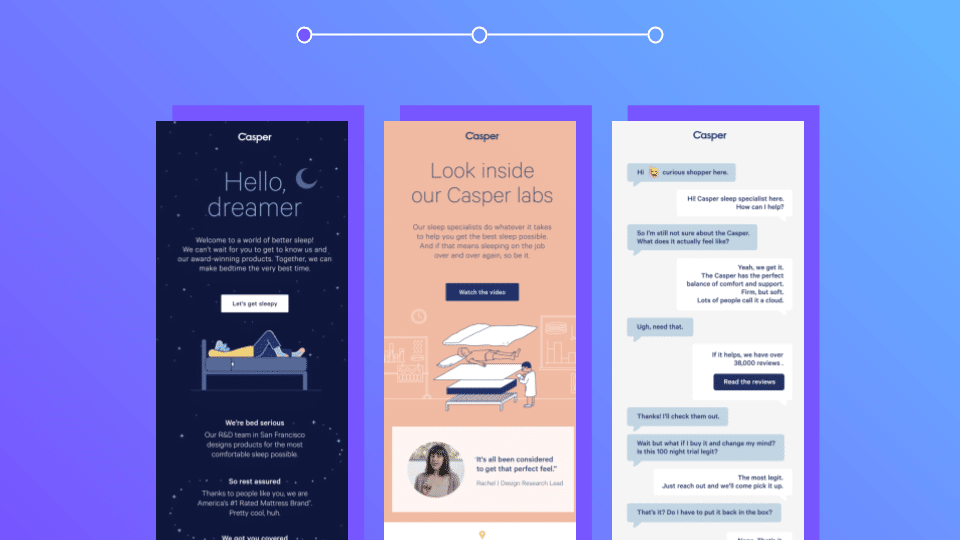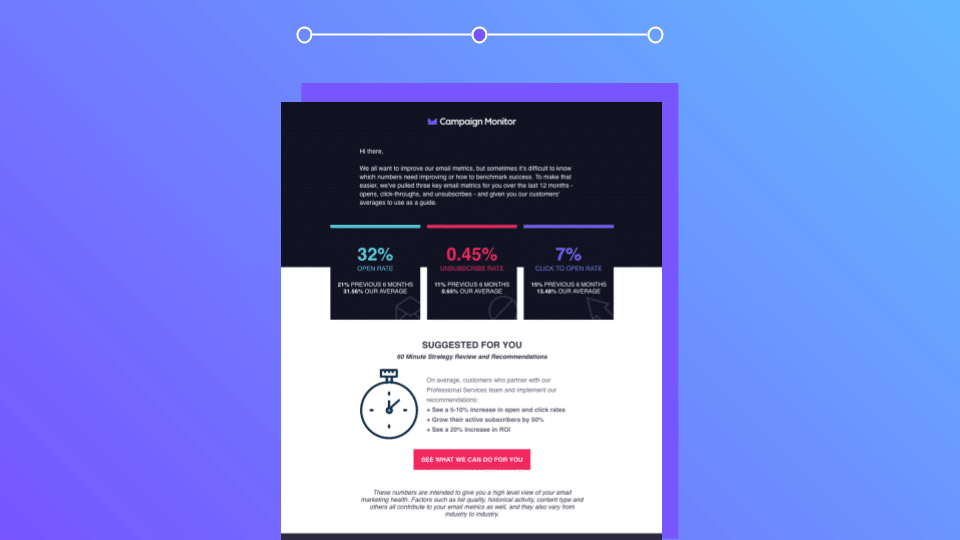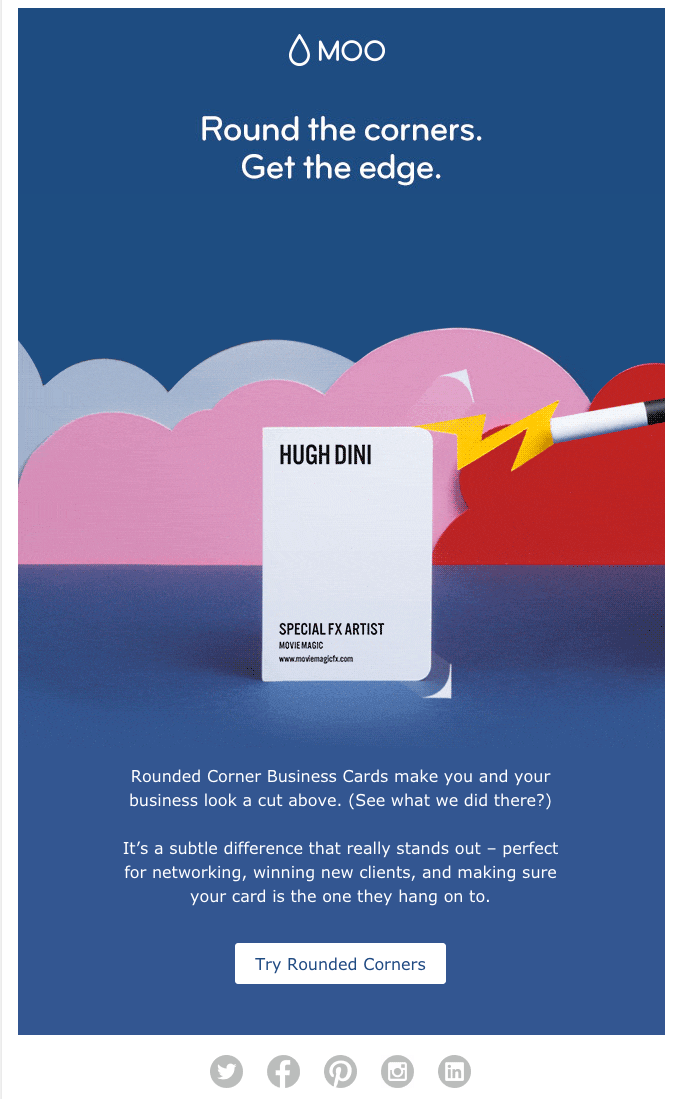This post has been updated as of May 2019
As a global company that empowers marketers to send emails, the GDPR is always at the forefront of our minds here at Campaign Monitor.
GDPR, the General Data Protection Regulation (GDPR), is a joint proposal by the European Commission, European Parliament, and the Council of the EU which provides individuals with even greater control over the collection and use of their personal data.
After its implementation in 2018, GDPR caused email marketers stress and anxiety as they wondered how the regulation would affect their business. We watched as companies around the world adjusted their plans in response to these new rules enforced by the European Union, and we changed our strategies to make sure our emails complied.
But today, we’re going to dispel some fears and shed new light on the positive aftereffects of GDPR. And beyond that, we’re even going to see how GDPR saved email marketing.
But to see its saving power, we must first reflect on a time when marketers around the world feared that their marketing programs were destined to die at the hands of GDPR.
Let’s take a minute to remember how each of us viewed marketing before GDPR.
GDPR: a year ago
Now think back to the feeling you had when this reality hit: that this regulation would fundamentally change how we do business in the future. For many of us, this question loomed in our minds:
“What will marketing look like after GDPR?”
And with it came questions like, “Will GDPR kill my email lists? Who can I market to after GDPR? Is this the end of my marketing programs?”
The added requirements of GDPR forced marketers to reexamine nearly every existing strategy, and companies expected the worst.
For thousands of companies, this news sounded like the end of our marketing strategy. We started thinking about how retargeting would work. How could we track people through a funnel? What would our data centers look like, and will leads slow to a crawl?
Look at some of these articles that popped up during that time:
“Will GDPR Kill Our Data-Driven Future?”
“The Dark Side of GDPR”
“Email Marketing Armageddon: The GDPR”
So May came, and companies worldwide prepared to put their compliance plans into action.
And what happened? It actually wasn’t as bad as everyone expected. Marketers thought their email lists were going to be obliterated. And they weren’t.
In fact, 60% of organizations that changed strategies due to GDPR compliant organizations saw less than a 10% change in their list size. Almost 20% saw NO change in their email lists.
And we ended up seeing headlines like these:
“Remember when they said GDPR would kill email? It didn’t.”
“How Content Marketing Can Benefit In A Post-GDPR World”
“3 Reasons Why Email Marketing Is Thriving Despite the GDPR”
So what did GDPR actually result in? I’m going to assert that the steps marketers took to comply with GDPR resulted in positive changes to their lists. One example of this can be seen in the ways many marketers approached the issue of consent leading up to May 25.
GDPR: one year later
So what did GDPR actually result in? The steps marketers took to comply with GDPR resulted in positive changes to their lists. One example of this can be seen in the ways many marketers approached the issue of consent leading up to May 25.
Once GDPR was established, many organizations chose to send out messages asking the questions:
“Are you interested in these emails? Do you want to keep hearing from us?” And for most companies, a lot of people responded with a solid “yes.”
But what about the people that chose not to respond? What about the ones who opened but didn’t give their consent, or the ones who didn’t even look at the message?
Aside from the GDPR implications of their response—these negative responders are just noise.
They’re the ones pulling your open and click rates down. They’re not engaged or interacting with your emails. And they’re diluting your email list because they’re simply not interested in your company. And this means that no matter how many emails you send them, they’ll never actually buy anything from you through this channel.
So when these people didn’t opt back into your lists, the quality of these lists actually improved.
With a year behind us, we can now see that we survived (and thrived) after GDPR. Numbers may have fallen in some cases—maybe your subscribers opted out, maybe your online visitors requested less data to be collected—but ultimately, GDPR has evened the playing field for consumers and companies.
Now that people understand how and why their data is being used, they’re more likely to be engaged with the brands they love and less engaged with the brands they don’t. Customers have a clear sense of what their options are.
Instead of ignoring emails or sending them to spam, GDPR gave subscribers the opportunity to say, “Yes, I want to keep receiving emails from you.” And in return, GDPR gave businesses an important wake-up call about engaged subscribers.
And here it is:
It’s not the size of your list that matters.
It’s not the size of your list that matters. Long gone are the days of grasping for every email address possible. List buying is no longer in vogue, and for good reason.
If you have a massive list, but no one on it opens your emails, and no one clicks through to purchase, you’re wasting your time, you’re wasting your resources, and you’re putting yourself in a terrible position for the future.
With a massive list of disinterested people, you’re first and foremost wasting resources. You’re spending time putting together these campaigns, and you’re spending money on big email marketing plans.
You’re now part of the 70% of marketers that say increasing their email list quality is their top objective.
But in addition to this, if no one on your list is opening your emails and you instead have subscribers marking them as spam, this is a BIG problem for your deliverability.
Deliverability is a mix of several different factors including your reputation as a sender, how often someone marks your message as spam, and even the credibility of your email service provider. But if everyone on your list flags your emails, or if you have an overwhelming amount of people consistently unsubscribing, no email service provider can save you. Your emails will start getting denied by email clients and your messages will stop being delivered.
This is why, even well-before GDPR, the tactic of list-buying was declining sharply. Some email service providers wouldn’t even accept users who’d purchased subscribers. At Campaign Monitor, we took that stance long ago, knowing this is not only a negative experience for subscribers, but for other marketers in our platform’s community.
And it all circles back to why these tighter regulations instituted by GDPR are in fact forming better habits and practices in marketers around the world. Even if you have the largest list out there, are your subscribers actually interacting with your emails? Are they actually converting?
Email must contribute to your revenue. Otherwise, you’re just wasting time and money. And historically, as your list grows by a variety of means, you eventually have subscribers that are disinterested in your content — which means they will never contribute to your revenue.
More regulation drives engagement.
Whether your list is large or small, the key to a successful email program is maximizing your audience’s engagement. And engagement is a natural byproduct of the renewed focus on the relationship between sender and recipient that’s prompted by the transparency, notice, and choice that GDPR requires.
Even at the forefront of your list building, GDPR requires every marketer to be transparent with how they’ll communicate to that recipient, and for that recipient to agree to those communications.
To put it in other words, when your subscriber signs up for communication from your company, there’s a clear understanding of what messages they’ll be receiving, and that they’ve raised their hand to receive those messages.
This understanding of expectations between sender and recipient places marketers in the perfect position.
Now that you know your audience is full of truly, uniquely interested customers, you can target them with specificity. Now you have more insight into who these recipients are, and you can craft precise messages to nurture their interest and drive engagement.
GDPR has not ruined marketing as we know it. These new regulations have instead elevated the level at which marketers can understand and communicate with their audience. And alongside this new level of marketing, we must evolve our strategy to take these conditions into account, creating high-performing, revenue-driving campaigns.
Create a high-performing email strategy.
What GDPR leaves us with, therefore, is the path to creating an extremely high-performing email strategy. By incorporating GDPR’s new standards into our strategies, we can now drive straight toward highly engaging, highly profitable email campaigns—which is why some statisticians expect that, despite these new regulations, company spending on email marketing is estimated to grow 48%.
So we’ve looked at how GDPR and its new requirements for consent help marketers instill confidence in the relationship between them and the individuals they market to. Now, let’s look at how the effects of this relationship can connect marketing efforts to revenue results.
We should mention that, whatever strategy you choose, you should always work with your privacy and legal team to make sure your organization’s privacy and other notices provide the right information to data subjects that support your strategy.
1. Thoughtful segmentation
First, we as marketers must continue to evolve the way we use segmentation to reach our customers.
Take what you know about your customer and use it to send timely, relevant messages.
Many marketers thought GDPR simply stripped back what we know about our customers. But data minimization isn’t all about getting rid of personal data. Under GDPR, it means that what you know about an individual should be “adequate, relevant and limited to what is necessary in relation to the purposes for which they are processed.”
So for example, knowing when and in what situation consent was given can be relevant when deciding what content to send a subscriber.
Consider when and how your subscribers sign up
You know about what they care about because of where and how they subscribed to your list. If subscribers came from your blog, you know they’re looking for informational content. If they subscribed at the time of purchase, they’re likely interested in more product-focused communications. Where and how they signed up for your list can already give you very specific characteristics that you can use to segment your list.
This level of segmentation directly leads to high-performing emails, as click-through rates are 100.95% higher in segmented email campaigns than non-segmented campaigns.
Even knowing when a subscriber signed up for your list can give you guidance on how you should communicate with them. You could set up automated messages to go out to specific segments of customers who purchased—and signed up for your emails—a week ago, 30 days ago, or six months ago. Think about your customer journey and align that with what you already know about your subscriber to send them timely, relevant messages that drive more conversions.
Nurturing your subscribers with content based on how they signed up, like in this email example from Casper, is a perfect tool to inspire more purchases.
Preference centers
Now, it’d be shortsighted of me to go through this topic of segmentation without mentioning preference centers.
Preference centers are incredible drivers of segmentation. Offering a preference center empowers your subscribers to select the exact types of communications they’re interested in. GDPR uses the word “choice” as a fundamental part of the definition of consent: an individual has a real option to consent, or not. And because they’re raising their hand to state their interest, this means they’re more likely to convert.
List segmentation using methods like a preferences center can lead to 39% better open rates, 28% lower unsubscribe rates, 24% better deliverability, 21% more transactions, and 15% better customer retention.
Now you can send specific communications to individual subscriber lists with the knowledge that they’re interested, allowing you to lean more heavily on overt conversion tactics.
Here’s an example from South By Southwest, a music and film festival in Austin, Texas. In this email, they point to the fact that they recognize their audience wants relevant messages. So they lay out precisely how to opt in for their various email lists, encouraging people to self-select the method that means they’re most likely to convert.
2. Content-driven programs
But segmenting your subscribers is half the battle. Segmentation allows you to get in the right headspace for communicating, filling out characteristic and interest guidelines for these groups. But if you take this knowledge and don’t follow up with content that caters to these interests, the result will be disengaged subscribers who will either ignore or unsubscribe from your emails.
Rich content is what propels engagement. So yes, step one is to segment. But step two is to follow up that segmentation with extremely relevant email content.
Deliver quality content
Building up interactive and compelling email experiences is top of mind for marketers, based on this report from Convince and Convert and Litmus.
And it’s this segmented, targeted, and relevant content that can generate 58% of your revenue.
Take this email we sent to our customers, for example. We created an extremely targeted email and filled it with content specific to the customer. And now this message is in the perfect spot to inspire future purchases, as the content directs the customer toward upgrading their account.
3. Personalized experience
And it’s this level of personalization that must happen for your entire audience. If not individually, then at least at the level of segmentation.
Automate your messages for hyper-personalization
Personalize the timeliness of your messages. Set up automated journeys or triggers to send timely messages to your segmented customers. Personalize the content beyond just their segment. Create unique messaging based on what emails they’ve clicked on, or what products they’ve purchased.
Creating segmented, relevant messages that are also delivered at the right time through automation can average 70.5% higher open rates, and 152% higher click-through rates than your standard emails. The example of our customer email from before is a perfect example of this level of personalization.
Another example of this perfectly timed and personalized email is from Moo, a printing company. They sent this email to a customer who had already purchased business cards, so they knew the customer would be interested in other business card offers. Then they timed it to deliver around six months after their last purchase, which may be when they need a refresher on their business cards. There’s an invitation to experience new content, not just to buy, with information to back up the experience.
The highest performing messages are just like this one: targeted, specific, relevant, and timely. These methods will elevate your email marketing far beyond what you can hope to accomplish with ads, media buys, or other digital methods.
You can be one of the marketers who have seen a 760% increase in revenue from segmented campaigns.
How GDPR Saved Email
GDPR refocused marketers on existing email best practices, further solidifying marketing programs for those who were already focused on delivering great experiences to their subscribers.
These same guardrails now give not only your subscribers an understanding of how they’ll hear from you, but they give your company an understanding of how your subscribers want to communicate.
And as we’ve seen, this puts your marketing efforts in a perfect position to interact with an audience that’s truly interested, empowering you to send engaging messages that are high-performing and influence your revenue. We, as marketers, can now target and strategize with intensity, intensely focusing on what we know about our customers. Now their expectations can truly move the needle for our businesses.
This is how GDPR has not only changed email marketing but has saved it.









